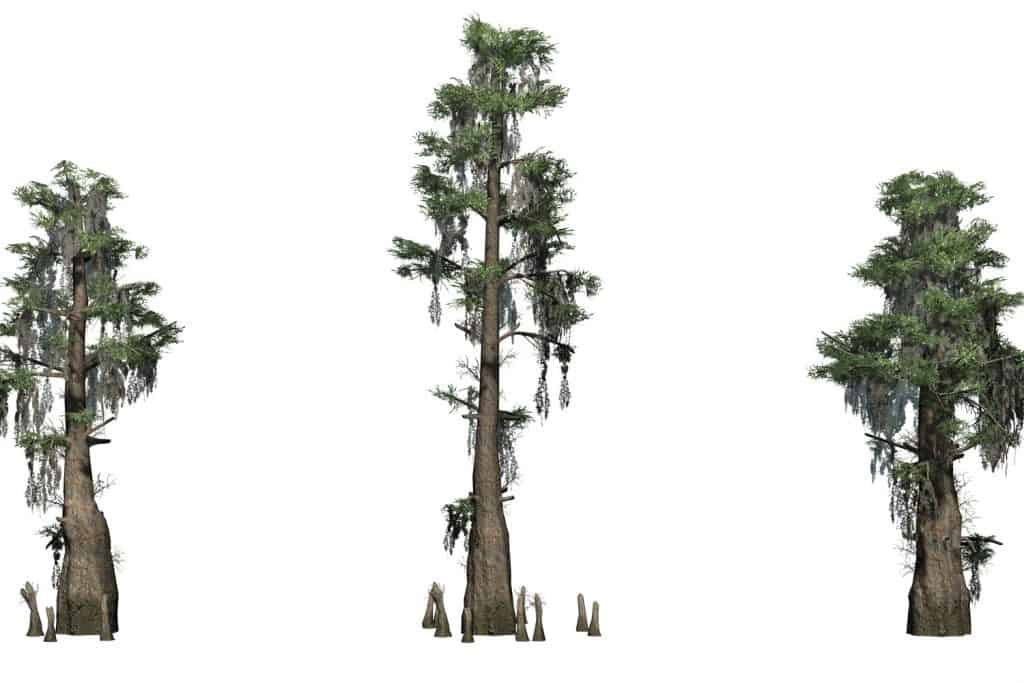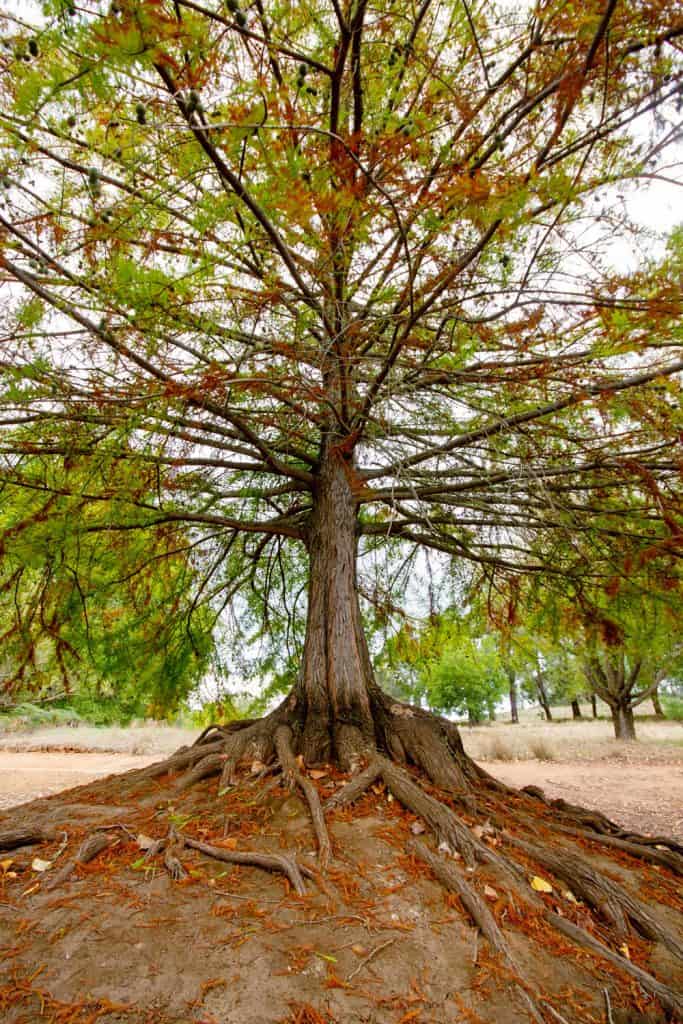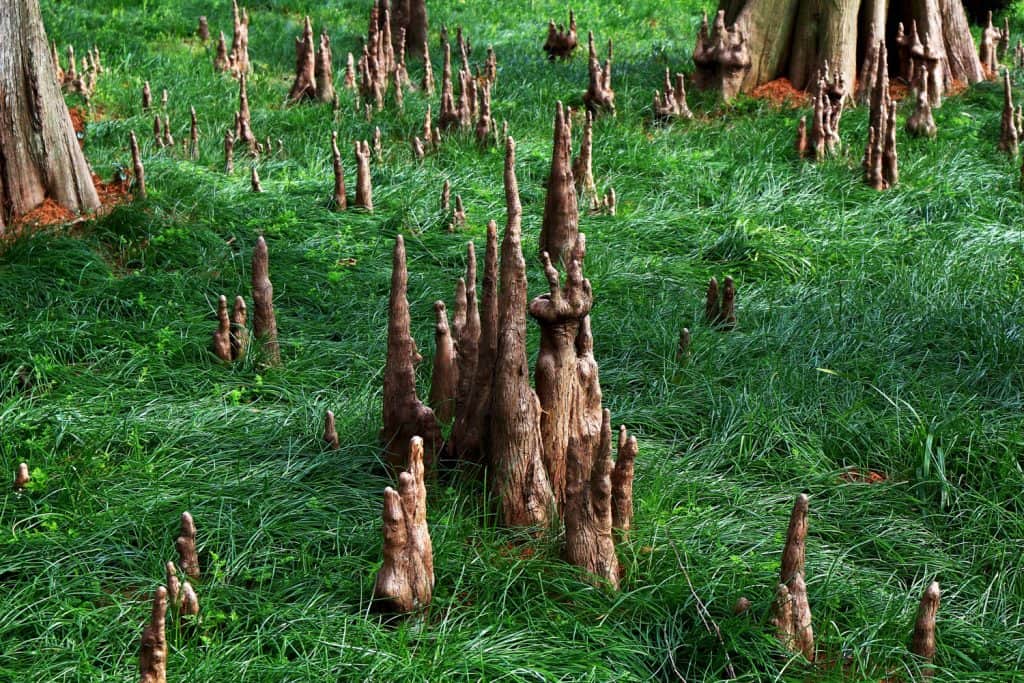Are you thinking about planting a Bald Cypress in your landscape? Before planting, it is wise to get familiar with the tree and their root systems. In this article, we will explain if the Bald Cypress has invasive roots and more.
Cypress trees [Taxodium distichum]), including the Bald Cypress, are known for their problematic roots, but they are not considered invasive roots. Not only is the rap root large, but the roots grow knobby knees that will rise above the ground.
You can avoid issues with the Cypress roots by planting them correctly. Keep reading as we explain how close to your house you can plant a Bald Cypress and answer how to get rid of the roots knees.

All About Bald Cypress
Bald Cypress, also known as the Swamp Cypress, is native to the Southeast of the United States. While they are commonly found in swampy or very wet landscapes, they can grow in various conditions.
These conifers drop their needles early in the season, which is why they are called "Bald" Cypress trees. They are planted as ornamental trees in many landscapes, popular for their orange and tan colors.

Given the right amount of space, you can watch these trees grow another two feet every year. These low-maintenance trees can live up to 600 years old, giving you a life-long tree when planted and cared for.
A defining characteristic of Bald Cypress is the knees or pneumatophores that come up out of their root system. These special roots create a unique look but can make some extra work for landscapers.
How Far Do Bald Cypress Roots Travel?
Bald Cypress trees are a conifer variety with a pyramid or cone shape. The roots of individual trees can vary based on the tree's height and overall size. The size may change based on the environment and location of the tree and the tree's age.
You can gauge how far tree roots travel by using the length of the canopy spread. Bald Cypress has a spread of about 20 to 30 feet, so you can expect the root system to travel at least that far.
How fast the root system spreads depends on the soil type, water levels, and overall tree growth. Cypress trees planted in swampy or otherwise very wet environments will have a slower root spread.

The length of root travel seems far, but the root system is still considered non-invasive. The roots grow far but remain shallow. The positioning of the roots causes far less damage to the surrounding areas.
Keeping up with pruning or reducing tree size can also help you manage the tree's roots. If you are planting a Bald Cypress within a small or limited landscape, restrict the tree from reaching its mature size to control root spread.
Can Cypress Tree Roots Damage Foundation?
While many trees can cause foundation damage, the roots of a Bald Cypress will not. If you are dealing with foundation damage caused by other species of trees, you can replace the problematic tree with a Cypress.
The roots of a Bald Cypress are fine, fibrous, and stay relatively shallow, which prevents them from causing damage to the foundation. What about the knees of these roots? Fortunately, the knees that pop up from the ground have not been known to cause foundation damage either.
However, Bald Cypress is a large tree, which is best suited for larger landscapes. While they do not cause damage to the foundation, they do have the potential to take up too much space, leading to damage to other plants or grasses.
Read more on our blog post, "Can Maple Tree Roots Damage Foundation?"
How Close To A House Can You Plant A Cypress Tree?
Due to the large size of these trees, you need to be mindful of where you plant them. If you plan to grow your tree near a house, it must be at least 15 feet [4.57 m] away from the home or other buildings.
Wherever you plant your Cypress, they will take moisture from the surrounding area because of their high water demand. Many gardeners will plant them in wet areas of the landscape, as they can correct areas with poor drainage or excess water.

Keep in mind the Cypress's knees. Knees can make it nearly impossible to cut the grass in the area and create tripping hazards in your yard. When planting, think about where the knees will come up. This can help you place the tree properly.
If you are planting multiple Bald Cypress trees, they need sufficient room between them to grow properly. Similar to the spacing between the house and your tree, each tree requires 15 to 20 feet between each other.
When you plant any specimen, you need to think about its size when it matures.
Read more on our blog post, "How Close To The Fence Can You Plant Arborvitae?"
Is It Bad To Cut Cypress Knees?
As knees come up, they may create inconveniences for you and your yard. You probably wonder if you can cut these knees to get rid of them and how it can be done without harming the tree.
Cutting Cypress knees is the most common way to get rid of them, so it is not bad for the tree if done right. If you have your tree planted in an extremely moist area, knees will pop up more often. This means you will have to cater to them more frequently.
Removing knees is technically damage to the tree. Ensure your tree is otherwise healthy before cutting the knees, and avoid removing knees in the critical root zone. This zone consists of a 12-inch radius around your tree.
As you cut off knees and the root system heals, this will promote new roots to grow. Unfortunately, once a Cypress tree starts producing knees, there is no way to make it stop. You will have to continue removing them as needed throughout the tree's life.
There are some tips and tricks to follow to reduce the damage done to your tree when removing knees. We'll talk about these next.
How Do You Get Rid Of Bald Cypress Knees?
Some Bald Cypress trees do not produce knees. Typically, those planted in well-drained landscapes with average soil will not have this issue. On the other hand, if your Cypress is surrounded by water or is planted in wet soils, it will get knees.
There is speculation that Cypress knees help to aerate the root system. Additionally, they may prevent erosion of the tree and create anchors to hold the tree in place in wet, moving environments.
If your tree does have knees to get rid of, you will want to do it carefully without damaging the root system.

Locate the knee you want to remove and dig around the area, a few inches deep, to expose more of the knee. Next, use a sharp, clean saw and make a horizontal cut through the knee.
You want the cut on the knee to be 1-2 inches below the soil. After cutting the knee completely off, cover the area again with soil. If you have numerous knees to remove, only remove a couple at a time. Give your tree time to rest and repair before another removal.
Never remove the knees by tearing them from the ground, chopping them with dirty tools, or using chemicals.
Are There Ways To Prevent Knees With My Bald Cypress?
Like mentioned, once these trees start producing knees, you cannot make them stop. However, the wet environments seem to promote more knee growth. You can prevent knees by paying close attention to the soil and environment.
Cypress trees planted in well-drained soil that receives infrequent watering can lower the risk of producing knees. Furthermore, infrequent watering can enhance the drought tolerance of Bald Cypress while promoting deeper roots.
Once you cut a knee off, another won't grow in the same spot. The best prevention is removing knees outside the critical root zone as soon as you notice them. Consistent monitoring will save you work later on.
In Summary
The root system of a Bald Cypress can grow far, but they remain shallow. Since the roots are shallow and somewhat soft, they are not considered invasive. We hope you found this article insightful when learning about your Cypress roots.
Are you searching for some non-invasive options? Have a look through our blog post, "15 Fruit Trees With Non-Invasive Roots".

Root has forked just before reaching the foundation of our home. The left fork turned when it reached the house and is now running alongside the house. The right fork is now headed straight down into the earth. I do not know where this right fork root is headed. So far, the roots have not caused any kind of damage to the brick foundation, however, I am concerned. Can these roots that have reached our foundation cause any structural damage to the foundation? Your thoughts and recommendations are appreciated. Jack